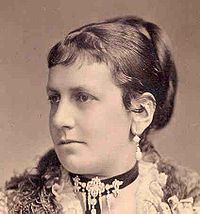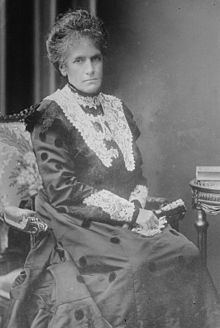Religion Catholicism Role Princess | Name Maria of | |
 | ||
Tenure 5 November 1913 – 7 November 1918 IssueMore Rupprecht, Crown Prince of BavariaAdelgunde, Princess of HohenzollernMaria Ludwiga, Duchess of CalabriaPrince KarlPrince FranzMathilde, Princess Ludwig of Saxe-Coburg and GothaPrince WolfgangPrincess HildegardePrincess NotburgaWiltrud, Duchess of UrachPrincess HelmtrudPrincess DietlindeGundelinde, Countess Georg von Preysing-Lichtenegg-Moos Children Rupprecht, Crown Prince of Bavaria Parents Archduke Ferdinand Karl Viktor of Austria-Este, Archduchess Elisabeth Franziska of Austria Similar People Ludwig III of Bavaria, Rupprecht - Crown Prince of, Archduchess Auguste Ferdinan, Princess Mathilde of Bavaria, Franz - Duke of Bavaria | ||
Maria Theresia Henriette Dorothee of Austria-Este (2 July 1849 – 3 February 1919) was a Queen consort of Bavaria. She was the daughter and only child of Archduke Ferdinand of Austria-Este and his wife, Archduchess Elisabeth of Austria. She was the last Queen of Bavaria.
Contents

Her paternal grandparents were Francis IV, Duke of Modena, and Princess Maria Beatrice of Savoy. Her maternal grandparents were Archduke Josef Anton of Austria and his third wife Duchess Maria Dorothea of Württemberg.
Ancestry and Family
Maria Theresa was born at Brünn in Moravia, now Brno in the Czech Republic. On 15 December 1849, when she was only five months old, her father Archduke Ferdinand died from typhoid. Maria Theresa was raised by her mother Archduchess Elisabeth. On February 20, 1868, at St. Augustine's Church in Vienna, Maria Theresa married future Ludwig III, last King of Bavaria.
The union was a happy one, and they had thirteen children:
Through her mother, Maria Theresa was the half sister of Archduchess Maria Christina of Austria (1858–1929), wife of King Alfonso XII of Spain; she was also first cousin to Princess Stephanie of Belgium, Crown Princess of Austria-Hungary; and Princess Clementine of Belgium, Princess Napoleon; and Archduchess Maria Dorothea of Austria, Duchess of Orleans.
Biography
On February 20, 1868, she married Prince Ludwig, eldest son of Prince Regent Luitpold, in the Augustinerkirche in Vienna. The couple had fallen in love with each other during a visit of Ludwig at Pfingsten in Austria to attend the burial of Archduchess Mathilda of Austria, who was his cousin and a friend of Maria Theresa, in representation of King Ludwig II of Bavaria in 1867, and they decided to marry, which initially angered the Emperor, who had wished for her to marry Ferdinand IV, Grand Duke of Tuscany. The chief witness was Count Antonius Schaffgotsch, just the one who baptised Maria Theresa the new princess.
After marriage, Maria Theresa spent most time raising her children. The couple lived a humble life in spite of the bright future that they would probably become King and Queen of Bavaria in future. With no official salary the family mostly lived on their farms at Leutstetten south of Munich, where Maria Theresa had her famous rose gardens.
Maria Theresa got various orders:
- Dame of the (Austrian) Order of the Starry Cross (January 10, 1865);
- Grand Mistress of the (Bavarian) Order of Theresia and of the (Bavarian) Order of Saint Elisabeth (October 19, 1872);
- Dame of the (Spanish) Order of Maria Luisa;
- The (Austrian) Order of Elisabeth 1st Class, the Order of Merit of the Bavarian Crown, the Cross of Merit for the Year 1870/71, the Cross of Merit for Voluntary Nursing, and the (Prussian) Red Cross Medal 2nd Class.
Maria Theresa became queen consort of Bavaria in 1913 when her husband the reigning Prince Regent proclaimed himself king as King Ludwig III in place of his living but insane cousin King Otto. She became the first Catholic queen in Bavaria since Bavaria was made a kingdom 1806. She spoke German, Hungarian, Czech, French, and Italian. In 1914, she hosted great festivities to the royal Bavarian jubilee and appeared with her spouse to announce the war. During World War I, she was a great patriot and also supported the Habsburg monarchy. She encouraged the women of Bavaria to support the soldiers by providing food and clothes for them with references to legendary heroines and visited wounded soldiers.
On November 7, 1918, Ludwig III was forced to abdicate Bavarian throne, and Maria Theresa fled Munich with her family to Wildenwart Castle near Frasdorf, in order to escape from Bolsheviks. The health of the Queen soon fell and she died there on February 3, 1919, and was buried at the local chapel. On November 5, 1921, her remains were transferred to the cathedral of Munich along with those of her husband, who died less than a month before.
Jacobite succession
Maria Theresa was the niece and heir of the childless Francis V, Duke of Modena who had been, at the time of his death, the Jacobite heir-general to the thrones of England, Scotland and Ireland; as such, she became the heir after his death in 1875. Neither she, nor any of her Jacobite forebears since 1807, ever seriously pursued this claim.
Maria Theresa was the first Jacobite heir-general since James Francis Edward Stuart (1688-1766) who could (but for her religion) also have claimed to be a natural-born citizen of Great Britain. While she was not born on British soil, as James had been, Maria Theresa was a descendant of the Electress Sophia of Hanover. Under the terms of the Sophia Naturalization Act 1705, the Electress Sophia and all "issue of her body" were declared to be natural-born British subjects, regardless of the actual place of their birth, unless they were Roman Catholics (or, as the Act called them, Papists). The 1705 Act was not repealed until 1948 and, consequently, Maria Theresa would have been covered by its provisions.
Following her death in 1919, Maria Theresa's son Rupprecht, Crown Prince of Bavaria inherited the Jacobite claim. Like his mother, he and his descendants have also refrained from pressing their claims to the British throne.
